Chicago’s landscape is quickly changing. As was reported by the Chicago Sun-Times, the Chicago Plan Commission has approved a 99-year lease for the development of the Lucas Museum of Narrative Art. With this immense project beginning to materialize, it is crucial that the city’s public infrastructure grows in tandem. The construction of the Lucas Museum in the Near South Side area represents an important contribution to one of Chicago’s most historically important neighborhoods. A beacon of cultural diversity, architectural excellence, and communal leadership, the South Side deserves access to both a vibrant collection of institutions as well as to equitable transportation. In a word, the South Side deserves the Gold Line.
The construction of the Lucas Museum presents a problem. The influx of patrons and subsequent traffic problems has not been dealt with by either the Mayor’s office or the developers. Although the initial plans include a parking garage, the increased congestion due to special events happening in and around Soldier Field will hamper residents and degrade infrastructure. The suggestions put forth so far include things like “extending bus rapid transit to the museum campus, creating a ‘dedicated trolley service’ to and from the Loop and West Loop rail stations and…adding water access via Burnham Harbor and a connection to the Lake Michigan Water Trail.” These propositions are a step in the right direction. But the answer is already staring the city of Chicago in the face.

The Gold Line is a revitalization of the existing Metra Electric railway servicing south Chicago by incorporating it into the CTA. By utilizing existing infrastructure, we can create the most economically viable option for addressing the transit needs of a community that has been calling for this even before the approval of the Lucas Museum. The Gold Line presents an opportunity to create access for patrons to the newly constructed museum, as well as to the University of Chicago, Illinois Institute of Technology, Museum of Science and Industry, and countless other landmarks that are underserved by our current system.

Beyond this, the increased frequency would boost commerce within all of the neighborhoods along the railway. Hyde Park, Bronzeville, and South Shore (to name a few) would see marked increases in business as customers along the Gold Line stream into shops, restaurants, and historic landmarks. This transit would help affirm Chicago’s dedication to sustainability, and the new stations would contribute to the city’s long history of innovative architecture.

This expansion would also serve to connect South Side residents out of work (Census data shows that in neighborhoods adjacent to the Gold Line, around 20% of the population over 16 is unemployed) to vacant jobs downtown and in other parts of the city. Giving more people access to jobs and cheaper alternatives to car ownership would increase the economic wellbeing of the whole region. The city deserves a holistic approach to growth, and the Gold Line can help make that happen.
In order to make the Gold Line a reality, there must be dedicated funds. As a community, we must encourage President Toni Preckwinkle and the Cook County Board to dedicate the $65 million of gas tax revenue that is to be diverted from the criminal justice system toward transit expansion. Sign our petition letter to tell your Cook County Commissioner that our region needs the Gold Line!





 Strengthening Transit Through Community Partnerships
Strengthening Transit Through Community Partnerships